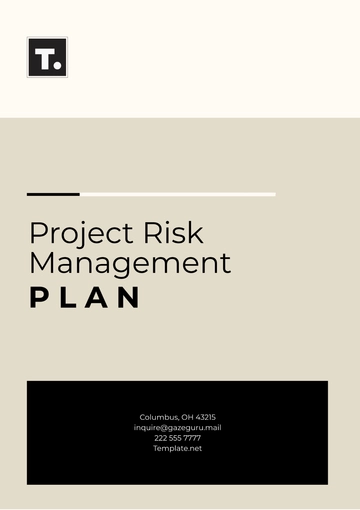Free Retail Business Contingency Plan

Prepared By: [Your Name]
Company: [Your Company Name]
Date: June 18, 2060
This Retail Business Contingency Plan serves as a comprehensive framework designed to mitigate risks, ensure business continuity, and provide recovery strategies for our retail operations. This plan outlines our organized approach in addressing disruptions, thereby safeguarding assets, sustaining customer service, and ensuring organizational resilience.
I. Introduction
The purpose of this contingency plan is to prepare for and respond to potential disruptions that may impact our retail operations. This plan encompasses all areas of our business, including supply chain management, sales, customer service, and data integrity, ensuring that each component can withstand and recover swiftly from unforeseen events.
II. Risk Assessment
Category | Examples |
|---|---|
Natural Disasters | Earthquakes, Floods, Hurricanes |
Supply Chain Disruptions | Vendor Bankruptcy, Transportation Strikes |
Cyber Attacks | Data Breaches, Ransomware |
Pandemics | Large-Scale Health Crises |
Market Fluctuations | Economic Downturns Impacting Consumer Spending |
III. Response Strategies
Natural Disasters: Establish relationships with local emergency services and prepare emergency kits for each retail location.
Supply Chain Disruptions: Diversify our suppliers and maintain sufficient inventory to reduce dependency and handle supply chain disruptions.
Cyber Attacks: Implement strong cybersecurity measures, such as advanced protocols, regular audits, and daily backups, to protect sensitive information and ensure quick recovery from breaches.
Pandemics: Enforce health protocols, shift to online sales, and implement flexible working conditions.
Market Fluctuations: Enhance financial planning strategies and develop marketing campaigns to boost sales.
IV. Roles and Responsibilities
Specific staff members will be assigned the following responsibilities to ensure efficient implementation of the plan:
Contingency Manager: Oversees the activation of the contingency plan and ensures compliance across all departments.
IT Department: The individual oversees the resolution of incidents related to technology and ensures the protection and security of digital assets.
Communication Officer: Carries out and manages the procedures and processes necessary for effective communication both within the organization and with external entities or individuals.
Operations Team: The individual oversees business processes and collaborates with suppliers for efficient operations.
V. Communication Plan
Internal Communication: Utilize email notifications, frequent intranet updates, and planned staff meetings as a holistic approach to guarantee that all employees remain consistently informed about significant news, changes, and developments within the organization.
External Communication: To effectively communicate with customers and stakeholders, issue well-crafted press releases, use social media for real-time engagement, and regularly update the corporate website. These strategies boost visibility and understanding of the organization's initiatives.
VI. Business Continuity Plan
To maintain operations during disruptions, the following measures will be employed:
Remote Work Capabilities: Create systems and infrastructure to support remote work for essential staff, enabling effective work outside the office.
Inventory Management: Implement thorough just-in-case inventory management strategies to successfully prevent and reduce the risk of stock outages or shortages.
Sales Flexibility: Enhance and develop online shopping and digital transaction systems to complement and support the sales that occur in physical retail locations.
VII. Recovery Plan
Following a disruption, the organization will take these steps to restore normal operations:
Damage Assessment: Please conduct a thorough evaluation of the impact and provide detailed documentation of the losses incurred.
Recovery Procedures: Implement strategies to restore and recover data, supply chains, and infrastructure.
Review and Reflect: Carry out a comprehensive evaluation following the event to revise and enhance the contingency plan, thereby strengthening its effectiveness and ensuring improved resilience against any future occurrences.
VIII. Training and Testing
Regular training and testing are crucial for effective contingency readiness:
Training Sessions: Training programs for all staff members will be conducted twice a year. These programs will emphasize the specific roles and responsibilities that each staff member has within the contingency plan.
Drills and Simulations: Conduct exercises every quarter to thoroughly assess the effectiveness of the plan and the responsiveness of the team.
Plan Review: Schedule annual reviews to adjust the plan as necessary based on technological or operational changes, starting from the year 2060 and beyond.
- 100% Customizable, free editor
- Access 1 Million+ Templates, photo’s & graphics
- Download or share as a template
- Click and replace photos, graphics, text, backgrounds
- Resize, crop, AI write & more
- Access advanced editor
Protect your retail operations from unexpected challenges with this Retail Business Contingency Plan Template. Cover supply chain disruptions, staffing issues, and revenue impacts with this editable and customizable plan. Editable in our Ai Editor Tool at Template.net, this tool is designed to keep retail businesses agile and prepared for uncertainties.
You may also like
- Finance Plan
- Construction Plan
- Sales Plan
- Development Plan
- Career Plan
- Budget Plan
- HR Plan
- Education Plan
- Transition Plan
- Work Plan
- Training Plan
- Communication Plan
- Operation Plan
- Health And Safety Plan
- Strategy Plan
- Professional Development Plan
- Advertising Plan
- Risk Management Plan
- Restaurant Plan
- School Plan
- Nursing Home Patient Care Plan
- Nursing Care Plan
- Plan Event
- Startup Plan
- Social Media Plan
- Staffing Plan
- Annual Plan
- Content Plan
- Payment Plan
- Implementation Plan
- Hotel Plan
- Workout Plan
- Accounting Plan
- Campaign Plan
- Essay Plan
- 30 60 90 Day Plan
- Research Plan
- Recruitment Plan
- 90 Day Plan
- Quarterly Plan
- Emergency Plan
- 5 Year Plan
- Gym Plan
- Personal Plan
- IT and Software Plan
- Treatment Plan
- Real Estate Plan
- Law Firm Plan
- Healthcare Plan
- Improvement Plan
- Media Plan
- 5 Year Business Plan
- Learning Plan
- Marketing Campaign Plan
- Travel Agency Plan
- Cleaning Services Plan
- Interior Design Plan
- Performance Plan
- PR Plan
- Birth Plan
- Life Plan
- SEO Plan
- Disaster Recovery Plan
- Continuity Plan
- Launch Plan
- Legal Plan
- Behavior Plan
- Performance Improvement Plan
- Salon Plan
- Security Plan
- Security Management Plan
- Employee Development Plan
- Quality Plan
- Service Improvement Plan
- Growth Plan
- Incident Response Plan
- Basketball Plan
- Emergency Action Plan
- Product Launch Plan
- Spa Plan
- Employee Training Plan
- Data Analysis Plan
- Employee Action Plan
- Territory Plan
- Audit Plan
- Classroom Plan
- Activity Plan
- Parenting Plan
- Care Plan
- Project Execution Plan
- Exercise Plan
- Internship Plan
- Software Development Plan
- Continuous Improvement Plan
- Leave Plan
- 90 Day Sales Plan
- Advertising Agency Plan
- Employee Transition Plan
- Smart Action Plan
- Workplace Safety Plan
- Behavior Change Plan
- Contingency Plan
- Continuity of Operations Plan
- Health Plan
- Quality Control Plan
- Self Plan
- Sports Development Plan
- Change Management Plan
- Ecommerce Plan
- Personal Financial Plan
- Process Improvement Plan
- 30-60-90 Day Sales Plan
- Crisis Management Plan
- Engagement Plan
- Execution Plan
- Pandemic Plan
- Quality Assurance Plan
- Service Continuity Plan
- Agile Project Plan
- Fundraising Plan
- Job Transition Plan
- Asset Maintenance Plan
- Maintenance Plan
- Software Test Plan
- Staff Training and Development Plan
- 3 Year Plan
- Brand Activation Plan
- Release Plan
- Resource Plan
- Risk Mitigation Plan
- Teacher Plan
- 30 60 90 Day Plan for New Manager
- Food Safety Plan
- Food Truck Plan
- Hiring Plan
- Quality Management Plan
- Wellness Plan
- Behavior Intervention Plan
- Bonus Plan
- Investment Plan
- Maternity Leave Plan
- Pandemic Response Plan
- Succession Planning
- Coaching Plan
- Configuration Management Plan
- Remote Work Plan
- Self Care Plan
- Teaching Plan
- 100-Day Plan
- HACCP Plan
- Student Plan
- Sustainability Plan
- 30 60 90 Day Plan for Interview
- Access Plan
- Site Specific Safety Plan





























